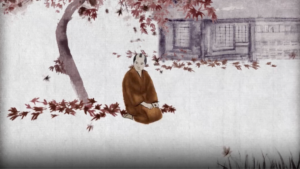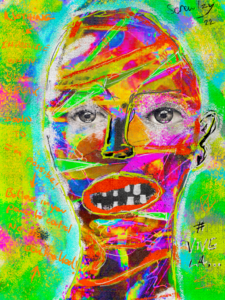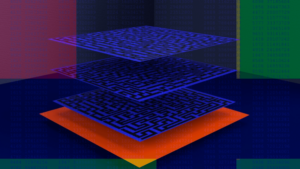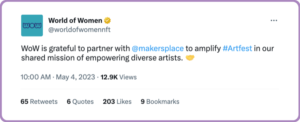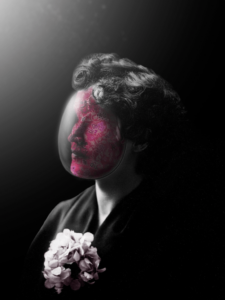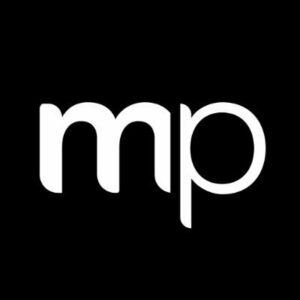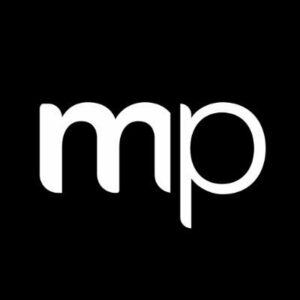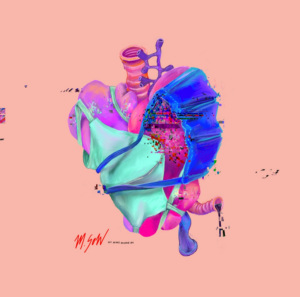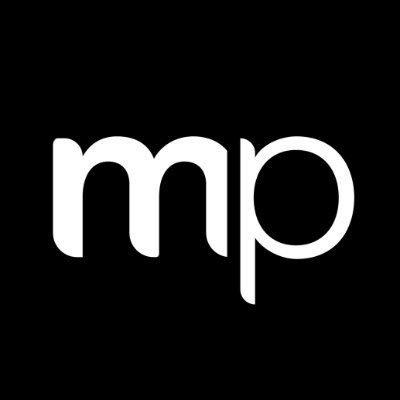
Listen to the episode on Apple Podcasts, Spotify, Overcast, iHeart, PlayerFM, Podchaser, Boomplay, Tune-In, Podbean, Google Podcasts, Amazon Music, or on your favorite podcast platform.
The article “Poetry Equals Art: A Brief Guide” inspired by this conversation, can be read here.
Brady Walker: Thank you for joining us today at Pixels and Paint, Ana Maria Caballero. Could you introduce yourself to our listeners?
Ana Maria Caballero: Hi, everyone. Hi, Brady. I appreciate the invitation. I’m Ana Maria Caballero, originally from Columbia, but I’ve spent much of my life in the US. I consider myself a poet, and inherently, an artist. I’ve published five books, including an NFT book, with a sixth one due next year. I entered the Web3 space out of a belief that poetry deserved a spot in areas where it was missing, like museums, exhibitions, and art fairs. I felt that Web3 solved a problem that poetry had – transactability. Though we buy books, it doesn’t always fully honor the poet’s craft or provide sustenance for the poet. So, I envisioned digital poems that could join in the revitalized interest in digital art spurred by Web3, and introduce people to poetry, while also offering interesting opportunities for poets.
Redefining the Value of Poetry
BW: Your motto is ‘poetry equals art.’ Could you expand on that a bit?
AMC: When I learned about Web3, I was immediately inspired to create a digital poetry gallery. It wasn’t just about selling my work, but also about supporting other poets, many of whom struggle to make ends meet while trying to get their work recognized. With traditional publishing, you often pay a fee and then wait for a year, without guarantee of exposure or remuneration. I had already been sharing my work on social media, and the response was encouraging. I thought it would be rewarding to share not just my work, but also the work of my friends, professors, and mentors through this gallery. I pitched the idea to several people and eventually found the perfect partners. The result was VERSEverse, featuring poems from South Florida poets, my professors, and other living legends in our opening collections.
Brady Walker: When I first encountered VERSEverse and tried to understand the idea of poetry as visual art, the forebear that came to mind was William Blake. Can you think of others, prior to NFTs, who approached poetry as a visual art form that should be displayed and enjoyed individually, rather than within the pages of a book?
Ana Maria Caballero: There’s a lot of text-based art, from Ed Ruscha to Cy Twombly to John Baldessari. So there are many examples of text in art.
Brady Walker: Christopher Wool is another that came to mind, particularly when I spoke with Pierre Gervois, who is a VERSEverse poet.
Ana Maria Caballero: Yes, Pierre is great. David Shrigley and Cecilia Vicuña also incorporate verse into their work. However, it’s rare to find a longer poem, such as those found in literary journals, embedded into artwork. Usually, they are short bursts of text. Longer examples might include the sloganistic neon sign art seen in museums and art fairs, but that’s a different manifestation.
Brady Walker: It’s unfortunate that the time most people spend looking at a single piece of art is far shorter than what most good art deserves. It’s unlikely that the usual viewing habits would accommodate a long-form poem. I’m trying to promote this concept of ‘slow looking’ at MakersPlace, which I think would benefit anyone wanting to enjoy long-form poetry paired with visual art.
Ana Maria Caballero: I agree. Poetry demands time and attention. You can’t just glance at it, like it, and move on. To get something from it, you really need to invest.
Poems in the Public Domain: A Study in Generative Readership
Brady Walker: The idea of revisiting work, rereading a piece, applies to visual art as well as poetry. Nowadays, people tend to see something once, scroll, like, maybe comment, and never revisit those pieces unless they’re in their collection. I find that revisiting work is often far more rewarding than the first go-through.
Ana Maria Caballero: I completely agree. I collaborated with a coder named Hieroglyphica on a collection called Poems in the Public Domain. We take public domain poetry and perform readership on it generatively. Fourteen to fifteen readers take turns discovering these classic poems. We use different pen colors to represent each person and the act of rereading.
BW: I was truly captivated by Poems in the Public Domain. It was my first encounter with crypto poetry that I wanted to delve into repeatedly. How did that project come about? Can you walk me through the ideation process?
AMC: Absolutely. The coder and I, who are friends and neighbors, had already collaborated successfully. He sent me an animation he’d developed, featuring letters floating off the page, and it was stunning. I wanted to use it to perform readership, to celebrate the marginalia that emerge when reading something that resonates deeply with you. He’s a talented coder, capable of creating complex visuals, but we wanted to keep this as stripped back as possible.
The work shows the poem, then pen marks start appearing, capturing thoughts, observations, reminders, and then the poem disappears. When it reappears, a new reader comes in and the process begins again. Over time, these layers of reading create a palimpsest of meaning. The work can run for hours in your browser, with countless variations. My collaborator also designed doodles, little trees, hearts, stars, arrows, and coffee rings, to make it feel less precious, to reflect the full range of readers.
This project’s heart is to demonstrate that it is reading that ensures poetry’s survival. Once a poem enters the public domain, it technically belongs to the reader. Poetry needs us to survive, and I believe our project encapsulates that beautifully, delicately, and slowly. We were mindful of balancing digital speed with the unhurried act of reading.
BW: I appreciate your effort to keep the comments diverse, not solely academic. In a sense, this piece seems to be teaching the art of reading. Some of my favorite books are commentaries on other texts, simply because I find the act of interpretation fascinating.
AMC: Mm-hmm.
BW: I’d like to shift focus briefly to your collectors. Are they poetry enthusiasts, art lovers, web3 degens, or a blend of all three?
AMC: I must give credit to my collectors, who I believe are visionaries. This is an exciting time for digital poetry, and the chance to collect works from living poets in a manner that honors the craft is revolutionary. While some are poetry lovers, not all are. Most are individuals who’ve delved into this niche and found it rich, thrilling, and full of nuance and depth.
What Does web3 Literature Look Like?
BW: How do you envision your work inhabiting someone’s life? Should it hang on a wall, stay in a wallet, or be accessed through a special app like on an iPad or Kindle for collecting literary NFTs? What’s the ideal experience?
AMC: Personally, I’m fond of using voice in my work, transmitting emotion and intent through my reading. So, ideally, it should be experienced with sound. Projections can be powerful, adding a materiality that screens sometimes can’t convey unless they’re high-quality. But projections with sound are my preference. Additionally, I believe my work is best experienced in the books I’ve written, allowing readers to hold them, read them, and write on the pages.
BW: This opens up a segue to some questions about your books. You have a new book, or rather a couple of new books, on the way. One is La Petit Mal, due out in June, correct?
AMC: It has already released in the UK and will be available in the US next week. The launch is at Powerhouse Books in Brooklyn, and I’m thrilled to announce that Charlotte Kent, an amazing writer and art historian, will join me for the event.
BW: Can you share some details about the book? It’s non-fiction, right?
AMC: Yes, it’s a non-fiction book. It was written during a period when my six-year-old son unexpectedly developed seizures. The book chronicles that journey, almost like live reporting, as I wrote while we were living through it. It was a cathartic outpouring of text, paired with photographs, doctor’s orders, receipts — a collection of artifacts from that time. It’s formatted in segments, filled with bursts of text, moments, memories. It pushes boundaries with grammar and punctuation, includes poetry, and excerpts from books I was reading then. It’s a multifaceted manuscript that documents a period of my life. The publisher struggled to define it — it’s a memoir, a medical memoir, a page-turner, and yet experimental, appealing to a creative writing audience.
BW: That sounds fascinating. I hope it’s not a spoiler, but how’s your son doing now?
AMC: He’s great now, thank God.
BW: I’m relieved to hear that. You also mentioned another upcoming book, a one-of-one piece, which you described as a book as a sculpture titled The Wish.
AMC: Yes, it’s a book I’m publishing myself in a single edition. I collaborated with a bespoke bookbinder to create this volume, which will be exhibited at an exhibition produced between VERSEverse and Avant Gallery, housed at a book gallery called Metamorphose in Paris. It contains one poem titled The Wish, published 197 times in its pages, representing a statement of value about poetry. I’m pricing it as a sculpture, and the collector will own the only edition of this book. While books are traditionally meant to be reproduced, this one isn’t. The poem also comes in a digital version read by me, which the collector will receive. But mainly, I’m presenting the book as the artwork.
BW: I love that. This leads me to a question about the digital manifestation of crypto poetry, versus the traditional book form. What drives you to add voice and visuals? What kind of creative satisfaction do you derive from creating a multi-dimensional piece compared to simply minting a page or a PDF?
AMC: That’s an excellent question. Poetry doesn’t devalue itself by participating in the visual narrative that exists in digital art today. Envisioning a poem in a format that speaks to generations who live their lives online doesn’t diminish the value of the printed page. By speaking their language to share your work, it helps them receive it to their and your benefit.
There are great opportunities for collaboration with artists which can create surprising works that neither of you might have done on your own. And yes, you can also mint poems as a PDF, which is a strong statement in itself. However, poets should consider experimenting and trying new things.
Exploring Web3 Publishing
BW: Have you seen mainstream publishers enter the web3 space in a meaningful way?
AMC: Not really. My experiences have primarily been with Web3 native publishers. However, Timepieces, led by Keith Grossman and Maya Dresin, deserve credit for their contribution to this space. I was part of the Deepak Chopra Timepieces collection. Also, Playboy created a collection on the theme of gender and sexuality which included one of my poems.
BW: Can you tell me about Alexandria Press?
AMC: Alexandria Labs, a Web3 publisher, published my collection of short stories called Tryst. They’re branching out in ways I find exciting, such as enabling credit card payments on their website and considering physical books. Their diverse range of first books from different artists and writers has been impressive. They are also enabling a self-publishing branch within their system, which I think will be well-received by writers.
BW: Absolutely. What do you envision for the Web3 literary world in, say, three years?
AMC: I foresee it absolutely thriving. My poetry has been exhibited at top galleries globally. Recently, I signed a contract with Diario ABC, a leading newspaper in Spain, to produce a series of digital poems for them. They plan to release them as NFTs for their readers. Their primary goal is to create awareness and educate readers about the potential of this new medium. They’re also interested in showcasing digital poetry as fine art in their museum. I’m confident that other organizations will also take the plunge, making this an exciting time for writers and poets active in this ecosystem.
BW: There’s so much room for innovative ideas in this space. Your interactive poems have demonstrated one aspect of what’s possible, sparking countless other ideas. You’ll be in Madrid for the Madrid Book Fair with this project, right?
AMC: Yes, I’ll be signing my book, “From Sunday to Sunday” (Entre Domingo y Domingo), in Spanish with my traditional publisher. I’ll also have meetings with the newspaper to plan our collaboration.
Writing Endlessly: The Influence of Family on Creativity
BW: Let’s focus on your work for a moment. You’ve described your work as a moment of private rebellion made in public. Can you elaborate on this rebellion?
AMC: Absolutely. I am aware of the dynamics of everyday conversations, especially those with loved ones. Family and motherhood are fertile sources of inspiration, leading me to question societal expectations placed on women. Coming from a largely conservative Colombian background, I’ve faced gendered expectations within family relationships. My direct, unadorned writing style has resonated with many who’ve experienced similar dynamics. As Virginia Woolf said, any woman who writes honestly about her life is a feminist. I believe that still holds true.
BW: How does home life inform your creative life?
AMC: It’s an evolving target. Each stage of life provides rich material, from pregnancy and early motherhood to aging parents. Although I’ve written extensively about home life, my current focus is on my aging parents. Alicia Ostricker, a revered poet, said she writes about family endlessly. That’s how I feel. There’s so much to explore in the way we treat or don’t treat each other. It’s a universal theme, and when shared, people often express surprise and gratitude that someone has articulated their experiences.
BW: How do you stay creatively open to being inspired by your everyday life?
AMC: Well, I find that my creative process has two main stages: writing and authoring. The writing stage is intense and overwhelming, where I get lost in a flurry of creation. This is then followed by the authoring stage where I edit, submit, and format my work for the digital space. This balance between writing and authoring works well for me. Even if editing isn’t about creating the raw material, it is very much a part of the writing process.
BW: Could you describe your process for generating the raw material?
AMC: It’s an act of writing furiously. I keep notebooks everywhere and just scribble thoughts as they come.
BW: Is there any structure to this process or is it more about spilling out ideas that you refine later?
AMC: I edit the raw material profusely afterward. I enjoy playing with form and rhyme during this editing phase, giving the piece a visual structure on the page, often with the aim of subtly hiding the rhymes. I find that rhyme can be astutely used to point out disturbing elements. A subtle hidden rhyme in a jarring piece can be immersive for the reader.
BW: So you’re talking about internal rhyme or playful alliteration?
AMC: Yes, and also a kind of messy rhyme. It doesn’t need to be perfect.
BW: I wanted to ask about POME, an especially performative digital art piece. Could you describe this piece and tell us how it came to be?
AMC: Absolutely, though I think it’s something you need to see to fully understand. I was invited by curator Annika Meyer to contribute to a tribute for Herbert Franke, a legend in the world of generative art and a poet. I’m not a coder, but I created a basic algorithm using P5.js, a coding language known for its elegant terminology. I aimed to highlight this elegance by creating a visual sensation of entrapment with circles of words going around and leaving a mark like words do. The commands in P5.js are incorporated into a commented out poem within the artwork. It is about emotional entrapment, and I’m pleased that it was collected by Kevin Abash, whose ‘Comment Out’ series greatly inspired my work.
BW: When working on a poem, at what point do you start to translate this into an NFT that is collectible and unique? I’m curious about the process of digitizing it.
AMC: Each process differs. Currently, I’m interested in using AI to create visuals in tension with the words. For example, I was asked to write a poem based on the writings of a historical figure who was fascinated with modernity. The poem is titled “Once Upon a Time, Modernity.” It’s about that magical moment when newness was enchanting. Using AI, I’ve tried to visualize the writer’s experiences by exploring artificial records grounded in reality.
BW: That’s interesting. Do you utilize chat GPT or large language models in your poetry?
AMC: Not really. I’m more of a traditional pen-to-paper writer.
Embracing Web3: Advice for Literary Artists
BW: How would you advise a literary artist unfamiliar with Web3 on entering this field?
AMC: The learning curve is steep, especially in terms of UX and UI. Patience and a willingness to learn are vital. Meg DeMatteo has written excellent articles on entering literary Web3, which I recommend. Above all, I’d say it’s a land of opportunity and genuine connections, so dive in.
BW: If you could advise your 20-year-old self on any aspect of creativity or the creative life, what would it be?
AMC: Trust your voice.
BW: Where can our readers and listeners find you?
AMC: You can find me on my website and on Twitter and Instagram.
BW: Any final remarks for our listeners?
AMC: I’d encourage anyone interested in my work to buy a book. Even though the price might not reflect all the effort that went into it, it’s still gratifying to have people read your work.
BW: Ana Maria Caballero, thank you for joining us today. I’m particularly enthusiastic about crypto poetry and its potential to revolutionize a medium that much of our culture has overlooked. I appreciate your contributions to poetry and your presence here today.
AMC: Thank you. I look forward to continuing the conversation.
Listen to the episode on Apple Podcasts, Spotify, Overcast, iHeart, PlayerFM, Podchaser, Boomplay, Tune-In, Podbean, Google Podcasts, Amazon Music, or on your favorite podcast platform.
- SEO Powered Content & PR Distribution. Get Amplified Today.
- PlatoData.Network Vertical Generative Ai. Empower Yourself. Access Here.
- PlatoAiStream. Web3 Intelligence. Knowledge Amplified. Access Here.
- PlatoESG. Automotive / EVs, Carbon, CleanTech, Energy, Environment, Solar, Waste Management. Access Here.
- BlockOffsets. Modernizing Environmental Offset Ownership. Access Here.
- Source: https://rare.makersplace.com/2023/06/15/transcript-e08-ana-maria-caballero-poetry-as-visual-art-publishing-on-chain-and-the-influence-of-family-on-creativity/?utm_source=rss&utm_medium=rss&utm_campaign=transcript-e08-ana-maria-caballero-poetry-as-visual-art-publishing-on-chain-and-the-influence-of-family-on-creativity
- :has
- :is
- :not
- :where
- $UP
- a
- ABC
- About
- About Crypto
- above
- absolutely
- academic
- accessed
- accommodate
- Act
- active
- add
- adding
- Additionally
- advice
- advise
- again
- Aging
- AI
- aim
- aimed
- algorithm
- All
- Allowing
- already
- also
- Although
- always
- am
- amazing
- Amazon
- an
- Ana
- and
- animation
- Announce
- Another
- any
- anyone
- app
- appealing
- Apple
- appreciate
- ARE
- areas
- around
- Art
- art piece
- article
- articles
- artificial
- artist
- Artists
- artwork
- AS
- aspect
- At
- attention
- audience
- authoring
- available
- Avant
- aware
- awareness
- back
- background
- Balance
- balancing
- based
- basic
- BE
- beautifully
- because
- been
- being
- belief
- believe
- belongs
- benefit
- bespoke
- BEST
- between
- Bit
- Blend
- blockchain
- book
- Books
- boundaries
- Branch
- briefly
- Brooklyn
- browser
- but
- buy
- by
- called
- came
- CAN
- capable
- Capturing
- card
- card payments
- celebrate
- chain
- Chance
- Charlotte
- Chopra
- Christopher
- circles
- classic
- coder
- Coding
- Coffee
- collaborated
- collaboration
- collect
- Collectible
- Collecting
- collection
- collections
- collector
- collectors
- Columbia
- come
- comes
- coming
- comment
- commented
- comments
- compared
- completely
- complex
- concept
- confident
- Connections
- conservative
- Consider
- considering
- contains
- continuing
- contract
- contribute
- contribution
- contributions
- Conversation
- conversations
- correct
- could
- Couple
- craft
- create
- created
- Creating
- creation
- Creative
- Creatively
- creativity
- credit
- credit card
- crypto
- Culture
- curious
- Current
- Currently
- curve
- David
- deepak
- Deepak Chopra
- demands
- demonstrate
- demonstrated
- depth
- describe
- described
- deserve
- deserves
- designed
- details
- developed
- DID
- different
- digital
- Digital Art
- digital space
- digitizing
- direct
- discovering
- displayed
- diverse
- do
- documents
- does
- Doesn’t
- doing
- domain
- done
- Dont
- Doodles
- drives
- due
- during
- dynamics
- each
- Each person
- Early
- ecosystem
- ed
- editing
- edition
- Editorial
- educate
- effort
- Elaborate
- elements
- embedded
- emerge
- enabling
- encounter
- encourage
- encouraging
- endlessly
- ends
- enjoy
- ensures
- Enter
- entered
- entering
- Enters
- enthusiastic
- enthusiasts
- envision
- episode
- Equals
- especially
- Even
- Event
- eventually
- everyday
- everyone
- evolving
- example
- examples
- excellent
- exciting
- exhibition
- Exhibitions
- exists
- Expand
- expectations
- experience
- experienced
- Experiences
- explore
- Exploring
- Exposure
- express
- extensively
- faced
- fair
- fairs
- family
- far
- fascinating
- Favorite
- Featuring
- fee
- feel
- field
- Figure
- filled
- final
- Find
- fine
- Fine Art
- First
- five
- floating
- florida
- Focus
- followed
- For
- form
- format
- Forward
- found
- friends
- from
- full
- fully
- galleries
- Gallery
- Gender
- generating
- generations
- generative
- genuine
- get
- Give
- Giving
- Glance
- Globally
- goal
- God
- going
- good
- Grammar
- gratitude
- great
- greatly
- guarantee
- had
- Hang
- Have
- he
- hear
- Heart
- helps
- her
- here
- hi
- Hidden
- high-quality
- Highlight
- historical
- hold
- holds
- Home
- Honestly
- Honors
- hope
- HOURS
- How
- However
- HTTPS
- i
- I’LL
- idea
- ideal
- ideally
- ideas
- if
- immediately
- immersive
- impressive
- in
- include
- included
- includes
- Including
- incorporate
- Incorporated
- Individually
- individuals
- influence
- inform
- inherently
- innovative
- Inspiration
- inspired
- intent
- interactive
- interest
- interested
- interesting
- internal
- interpretation
- into
- introduce
- Invest
- invitation
- invited
- iPad
- IT
- ITS
- itself
- John
- join
- joining
- joining us
- journey
- june
- just
- Keep
- keith
- Kind
- known
- Labs
- Land
- language
- large
- largely
- later
- launch
- layers
- leading
- Leads
- LEARN
- learned
- learning
- leaving
- Led
- Legends
- less
- Life
- like
- literature
- little
- live
- Lives
- living
- longer
- Look
- look like
- looking
- lost
- Lot
- love
- loved
- lovers
- made
- Main
- mainly
- Mainstream
- make
- Making
- manner
- many
- maria
- mark
- material
- Maya
- maybe
- me
- meaning
- meaningful
- meant
- Media
- medical
- medium
- Meet
- meetings
- Memories
- mentioned
- Meyer
- might
- mind
- mint
- minting
- missing
- models
- moment
- Moments
- more
- most
- Motto
- move
- much
- multifaceted
- Museum
- Museums
- must
- my
- Named
- NARRATIVE
- native
- Need
- needs
- neighbors
- Neither
- Neon
- never
- New
- next
- next week
- NFT
- NFTs
- notebooks
- now
- Nuance
- of
- off
- offering
- often
- on
- once
- ONE
- ones
- online
- only
- open
- opening
- opens
- opportunities
- Opportunity
- or
- orders
- organizations
- originally
- Other
- Others
- our
- out
- over
- own
- page
- pages
- paint
- paired
- parents
- paris
- part
- participating
- particularly
- partners
- Patience
- Pay
- payments
- People
- perfect
- perform
- period
- person
- Personally
- phase
- photographs
- physical
- piece
- pieces
- Pierre
- pitched
- plan
- platform
- plato
- Plato AiStream
- Plato Data Intelligence
- PlatoAiCast
- PlatoData
- playing
- pleased
- plunge
- podcast
- Poetry
- Point
- possible
- potential
- powerful
- Precious
- Pregnancy
- presence
- press
- price
- pricing
- primarily
- primary
- Prior
- private
- Problem
- process
- produce
- Produced
- project
- projections
- projects
- promote
- provide
- provides
- public
- published
- publisher
- publishers
- Publishing
- pushes
- question
- Questions
- range
- RARE
- rather
- Raw
- Read
- Reader
- readers
- Reading
- Reality
- really
- receipts
- receive
- recently
- recognized
- recommend
- records
- refine
- reflect
- Relationships
- release
- released
- remuneration
- REPEATEDLY
- Reporting
- represent
- representing
- resonates
- response
- result
- revolutionary
- revolutionize
- rewarding
- Rich
- right
- Room
- Run
- Said
- satisfaction
- say
- screens
- scroll
- see
- seems
- seen
- segments
- SELF
- Selling
- sense
- sent
- Series
- several
- Share
- shared
- sharing
- she
- shift
- Short
- should
- show
- showcasing
- Shows
- sign
- signed
- signing
- similar
- simply
- single
- sixth
- Slowly
- So
- Social
- social media
- societal
- solely
- some
- Someone
- something
- son
- Sound
- Sources
- South
- Space
- Spain
- Spanish
- speaking
- Speaks
- special
- speed
- spend
- spent
- Spot
- Spotify
- Stage
- stages
- Stars
- start
- Statement
- stay
- Still
- Stories
- strong
- structure
- Struggle
- Study
- Stunning
- style
- submit
- Successfully
- such
- Supporting
- surprise
- surprising
- survival
- survive
- system
- Take
- talented
- talking
- Target
- Teaching
- technically
- tell
- terminology
- terms
- than
- thank
- that
- The
- the UK
- the world
- their
- Them
- theme
- then
- There.
- These
- they
- things
- think
- this
- those
- though?
- thought
- three
- thrilled
- thrilling
- thriving
- Through
- time
- timepieces
- times
- titled
- to
- today
- top
- traditional
- traditionally
- Transcript
- translate
- treat
- Trees
- tried
- true
- truly
- Trust
- turns
- two
- ui
- Uk
- understand
- unfamiliar
- unfortunate
- unique
- Universal
- unlikely
- upcoming
- upon
- us
- use
- used
- using
- usually
- utilize
- ux
- value
- Verse
- version
- Versus
- very
- viewing
- virginia
- visionaries
- visual art
- visuals
- vital
- Voice
- volume
- wait
- walker
- Wall
- Wallet
- wanted
- wanting
- was
- Way..
- ways
- we
- Web3
- Web3 space
- Website
- week
- WELL
- went
- were
- What
- when
- which
- while
- WHO
- whose
- will
- Willingness
- with
- within
- without
- woman
- Women
- words
- Work
- working
- works
- world
- would
- write
- writer
- writing
- written
- year
- years
- yes
- yet
- you
- Your
- yourself


